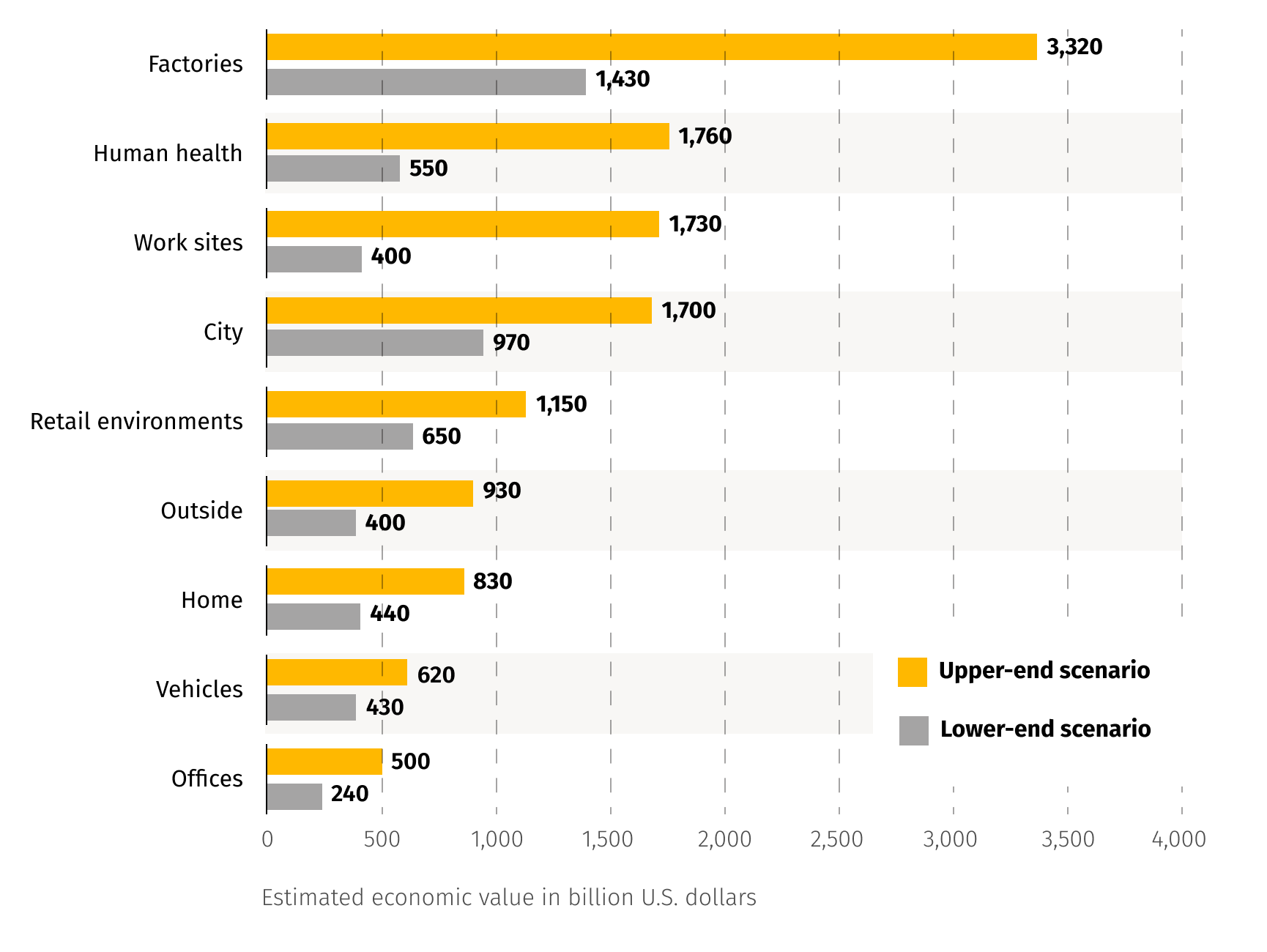
Capturing the value of IoT across industries
The Internet of Things (IoT), which was merely a concept a few years ago, has now become one of the major disruptors across industries. Its implications are profound and far-reaching: from optimization of operations and effective management of physical assets to improving the health and general well-being of both consumers and employees alike.
The economic payback of IoT efforts is also quite impressive – by the end of the decade, it could generate between \$5.5 to \$12.6 trillion in value globally. But how to capture that value? Analyzing the practices employed by leading companies suggests their approach to the IoT is based on a clear understanding of the commercial opportunities this technology has to offer, and strict adherence to the IoT program across all business units and functions. We outline some of these practices below so you can make the best out of your IoT transformation.
Catch up on the accelerating opportunities of IoT

There are around 13.1 billion IoT devices worldwide, and by 2030 this number is projected to reach 29.4 billion. All these smart appliances generate a wealth of data that enables the identification, tracking, monitoring, and management of various assets. The particular scope and application of IoT solutions vary from industry to industry. Here are just a few examples of the opportunities provided by this technology across the major industry verticals.
Smart manufacturing
Industry 4.0 is here, and the IoT is one of its primary drivers. The factory setting is currently accountable for 26% of the IoT’s total value potential. By 2030 IoT applications in smart manufacturing are projected to generate between \$1.4 trillion and \$3.3 trillion, which makes it the most lucrative domain of all.
Forward-thinking companies are already employing this technology to boost their process reliability through:
- Quality control. IoT analytics platforms can collect data from all endpoints and track critical metrics to provide business users with comprehensive insights into the manufacturing workflow, enabling automated auditing and timely resolution of production-related issues.
- Predictive maintenance. Since all the equipment is connected wirelessly to the internet, manufacturers can receive real-time data from assembly lines to identify early signs of failure and plan timely maintenance schedules. This allows them to avoid downtime, improve the safety of manufacturing operations, increase efficiency, and reduce the cost of poor quality.
- Machine health monitoring. IoT sensors can calculate the vibrations of compressors, motors, robotic equipment, and take precise measurements of the surrounding temperature, acceleration, displacement and sound frequencies to detect if the machines operate under normal conditions.
Insurance
Implementation of technological advancements in the insurance ecosystem allows industry leaders to shift their value proposition from risk coverage to risk prevention. By leveraging data that streams from smart devices, wearables, sensors, and telematics insurers gain actionable insights that can help predict and avert possible damage, reducing costs:
- Improved safety. IoT empowers insurers to extend security standards, changing their approach from reactive to proactive. For example, by monitoring the state of electricity, gas, and water supply systems through smart home devices they can duly detect critical conditions and trigger automatic maintenance, improving the prevention mechanisms.
- Dynamic pricing. Having access to the data flowing between connected devices, insurance companies can better understand their customer’s behavior to introduce usage-based coverage, e.g. by offering discounts or lower premium rates to vigilant drivers.
Digital commerce
The market size for IoT in e-commerce was valued at $28.14 billion in 2021 and is estimated to be worth $177.90 billion by the end of the decade. The rise of connectivity technologies is readily explained by the vast opportunities it can offer to retail brands, including access to data on customer activity during shopping, improved tracking and logistics, and effective inventory management. This translates into the following IoT use cases:
- Customer personalization. Modern technologies can support brands in gaining useful information about their customers, enabling them to deliver tailored shopping experiences. For example, with IoT updates on a device’s warranty status retailers can not notify clients about potential problems on time, but also offer additional coverage or upgrade, forwarding them ads of the new model range.
- Supply chain execution. Employing cloud-based technologies such as Radio Frequency Identification tags (RFID) and GPS offers retailers real-time insights into what is happening with the product, from its status and condition to speed, precise location, and estimated time of arrival to the next touch point. IoT devices can also provide information on weather, traffic, fleet and driver capacity for a better understanding of fulfillment risks and more efficient logistics management.
- Order fulfillment. IoT offers retailers continuous visibility into inventory management. By leveraging smart sensors, top-of-the-shelf displays, and beacons they can see when a product enters or leaves the storage facility, monitor the number of specific items, and automatically place orders for new batches. The data generated through the IoT ecosystem thus enables capabilities for balancing order pick rates, online availability rates, and stock replenishment.
Create business scenarios for the use cases of IoT technologies
IoT often stands at the forefront of operation optimization and human-productivity business domains. But at the early stages, these use cases rarely produce the kind of economic impact that can encourage businesses to move beyond their pilot efforts.
According to McKinsey, the first 15 or so IoT use cases typically have quite a modest payback. This number often marks a division between the top-tier performers and their less successful peers. Organizations with a mature innovation strategy tend to follow the principle of “the more the better”. They implement around 30 IoT applications on average, which not only allows them to reap the benefits of their efforts much faster than slower-moving companies but also yields revenue and cost improvement of at least 15%.
Transform your organization to unlock the IoT’s potential
Many enterprises mistakenly perceive IoT as a pure technology play rather than an operating-model transformation. Treating it just as an IT function carries the risk that companies might overlook the value they can capture by adopting a holistic approach that requires comprehensive procedural, organizational, and cultural changes.
To fully realize IoT efficiencies, enterprises need to redesign their core operational processes, encourage employees to align their work routines with the new business mode, and introduce vigorous performance management. From this vantage point, IoT seeks to empower businesses with tremendous competitive advantages, faster innovation, better productivity, and enhanced customer experiences.
Mobilize the entire company to launch the IoT initiative
Since IoT deployment is a complex program that affects different aspects of corporate activity, it requires organization-wide commitment and collaboration of cross-functional actors. Everyone, from C-level executives and managers to frontline workers, has to understand and get behind the IoT strategy to get the project off the ground.
Digital transformation imposes unfamiliar demands on all enterprise domains so staff members will have to learn fresh skills to manage novel and unforeseen opportunities and threats. Designing, building, maintaining, and expanding IoT solutions across the organization will also require employees to go beyond their business and functional boundaries to enable maximum value capture.
Leverage technology partnerships
Strong alignment with IoT priorities and internal support of the new operational model gives a solid foundation for technology advancement. However, relying solely on homegrown capabilities poses numerous system barriers, hindering the company’s ability to scale and integrate.
The preference of IoT leaders suggests a greater willingness to explore the capabilities provided by the ecosystem of technology partners rather than put the in-house IT department at the helm of their innovation efforts. Working with outside vendors allows them to effectively enforce an interoperability strategy, enabling seamless integration of different use cases, solutions, and suppliers. Moreover, this way they can choose the IoT platform that will meet all their business requirements.
Interested to learn how Grid Dynamics can help build or support an IoT technology foundation? Get in touch with us to start a conversation.
